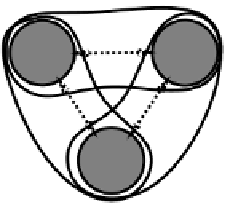Information Technology Reference
In-Depth Information
Monitor
Speakers
Keyboard
synthesizer
key−
board
spea−
ker
Hidden
mon−
itor
Input
Figure 9.17:
Three related items (television, terminal, syn-
thesizer) represented in an overlapping, distributed fashion as
two out of three common features.
Figure 9.18:
Network for exploring active maintenance.
trial
Event
cycle
Input
Hidden
0
Input
9
basins are necessary. These wider basins are present in
the final configuration we explore, where the units are
completely
isolated
from each other. This completely
prevents activation spread and yields very robust active
maintenance (O'Reilly et al., 1999a), but at the loss of
the ability to perform inference via activation spread.
To explore these ideas, we use the simple overlap-
ping distributed representations of a
television
,
synthe-
sizer
,and
terminal
in terms of the features of
keyboard
,
speaker
,and
monitor
, as shown in figure 9.17. This
is the same example that we explored in chapter 3, in
the context of a similar kind of problem with activa-
tion spread in distributed representations. Note that in
this earlier case, the problem was solved by using inhi-
bition. That will not help here because, unlike before,
there will be no external inputs to favor the activation of
the appropriate units.
0
Input
19
. . .
0
Input
89
0
Input
99
1
Maintain
9
1
Maintain
19
1
Maintain
29
. . .
1
Maintain
89
1
Maintain
99
Figure 9.19:
Grid log showing spreading activation and loss
of maintained information with distributed interconnectivity
among the hidden units.
You should see the bidirectional excitatory connec-
tions among the three hidden units, which in theory
might enable them to actively maintain the representa-
tions even after the input pattern is turned off.
There are two “events” in the environment, one where
an input pattern is presented to the network, and another
where the input is zeroed out (not presented). We are in-
terested in how well the information in the hidden units
is maintained during this second event.
Exploring the Model
Open the project
act_maint.proj.gz
in
chapter_9
to begin.
You will see that the network has three hidden units
representing the three features (figure 9.18). The input
units provide individual input to the corresponding hid-
den unit. In an active maintenance context, one needs to
have the individual features of a distributed representa-
tion mutually support each other via excitatory connec-
tions.
Return to viewing
act
in the network, and then
press the
Run
button.
You will see the network presented with inputs and
the units respond, but it will probably be too quick to
get a clear idea of what happened.
View
r.wt
in the network window and select the
different hidden units to view their weights.
Do
View
,
GRID_LOG
, and then
Run
again.









































Search WWH ::

Custom Search